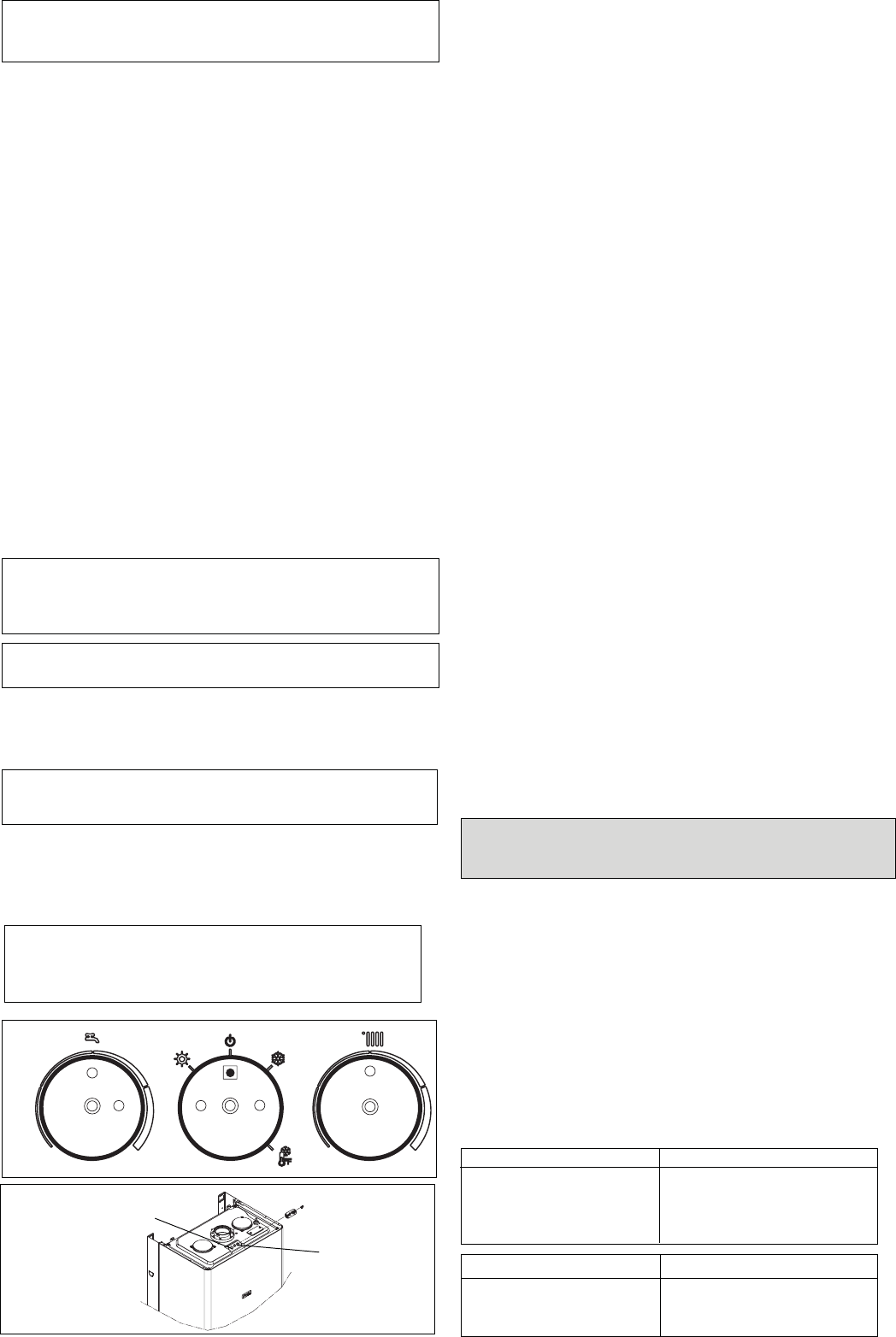
47
NOTICE:
When the request for heating and/or hot water has
been satisfied, the boiler pump and fan may continue to
circulate to dissipate any residual heat within the boiler.
7. BOILER FAN SPEEDS
The boiler fan speeds require to be checked and/or adjusted
prior to making any adjustments to the gas valve or if the main
PCB has been replaced.
ATTENTION
Gas type and appliance fan speed (output) must be set according
to the specific appliance specification. Raypak accepts no
responsibility if the gas type and/or fan speed is not correctly adjusted
according to the respective appliance specification as detailed on
the appliance data badge.
CHECKING/ADJUSTING THE BOILER FAN SPEEDS
Move the selector switch to the OFF position and remove the 3-
selector knobs.
ABSOLUTE MAX FAN SPEED
Locate the MAX trim pot (Fig. 59) and gently adjust clockwise or
counterclockwise to achieve the correct fan speed (see Table 10 below).
NOTICE:
The display shows the fan RPM in multiples of 1000,
i.e. 2.5 = 2500RPM.
ABSOLUTE MIN FAN SPEED
Locate the MIN trim pot (Fig. 59) and gently adjust clockwise or
counterclockwise to achieve the correct fan speed (see Table 10 below).
NOTICE:
The display shows the fan RPM in multiples of 1000,
i.e. 2.5 = 2500RPM.
IGNITION FAN SPEED
NOTICE:
Do this operation only after the adjusting of
absolute max and min fan speed.
Locate the IGN trim pot (Fig. 59) and gently adjust clockwise or counter
clockwise to achieve the correct fan speed (see Table 10 below).
NOTICE: The display shows the fan RPM in multiples of
1000, i.e. 2.5 = 2500RPM.
HEATING FAN SPEED
Locate the HTG trim pot (Fig. 59) and gently adjust clockwise or
counter clockwise to achieve the correct fan speed (see Table 10
below).
NOTICE: The display shows the fan RPM in multiples of
1000, i.e. 2.5 = 2500RPM.
8. CHECKING THE CO2 AND ADJUSTING THE GAS VALVE
THE GAS VALVE MUST BE SET-UP OR ADJUSTED WITH THE
AID OF A PROPERLY CALIBRATED FLUE GAS ANALYZER.
Isolate the boiler from the electrical supply and remove the casing
as described in Fig. 33. Set the flue gas analyzer to read CO2 and
insert the probe into the flue analysis test point (Pos. B in Fig. 59a).
Restore the electrical supply to the boiler and switch the boiler to
the OFF mode. To adjust the gas valve you must first ensure that
the fan speed potentiometers (trim pot) have been set correctly
(Tab. 10).
Remove the 3-selector knobs, locate and press the CO button
(Fig. 59). The appliance will now operate in CO mode for
approximately 15-minutes.
9. GAS VALVE MAXIMUM PRESSURE SETTING (Fig. 61)
Locate and gently turn the HTG trim pot until the maximum value
(max fan speed) is obtained and check that it corresponds with
the appropriate CO2 value (Maximum) for the respective boiler
(see the data table for values). If the CO2 reading is correct,
proceed to gas valve minimum setting. However, if the CO2 reading
is incorrect, the maximum gas pressure must be adjusted as
follows:
- Using a suitable screwdriver, very slowly turn the maximum
pressure adjustment screw (Fig. 60)– clockwise to decrease,
counter clockwise to increase – until the correct value is
displayed on the CO2 analyzer (allow time for the analyzer to
stabilize).
FAN SPEED TABLE
Use the following table to set the corresponding fan speeds that
are relative to the boiler you are working on.
FAN SPEED (rpm) TABLE Tab. 10
MODEL MAX MIN HTG IGN
85 5,800 2,000 5,800 3,700
120 5,600 1,500 5,600 3,700
HTG
TMR
MIN
MAX
CO
IGN
Fig. 59
Fig. 59a
10. GAS VALVE MINIMUM PRESSURE SETTING
Locate and gently turn the HTG trim pot until the minimum value
(min fan speed) is obtained and check that it corresponds with the
appropriate CO2 value (Minimum) for the respective appliance. If
the CO2 reading is correct, rotate the HTG trim pot until the correct
value is obtained for the respective appliance (see fan speed Tab. 10).
However, if the CO2 reading is incorrect, the minimum gas
pressure must be adjusted as follows:
- Remove the sealing screw
- Using a suitable screwdriver, very slowly turn the minimum
pressure adjustment screw (Fig. 60) – clockwise to increase,
counter clockwise to decrease - until the correct value is
displayed on the CO2 analyzer (allow time for the analyzer to
stabilize).
COMPLETION
On completion of the combustion analysis check and/or any gas
valve adjustment, set the HTG trim pot to the corresponding value
as detailed in the fan speed table. Reattach the 3-selector knobs.
Remove the test probe from the test point and reattach the sealing
screws and/or cap.
DANGER: A GAS TIGHTNESS CHECK MUST BE CARRIED
OUT IF ANY GAS CARRYING COMPONENTS HAVE BEEN
REMOVED, REPLACED, OR DISTURBED.
11. COMBUSTION ANALYSIS TEST
A combustion analysis check can easily be carried out on the
boiler via the test points located on the top of the appliance.
- Insert the flue gas analyzer probe into the flue gas test point
(Pos. B in Fig. 59a).
- Operate the boiler in CO mode and compare the values with
those shown in Tab. 1 (Nat. Gas) or Section 13 (LPG). If different
adjust the gas valve accordingly.
12. EXTERNAL FAULTS
Before carrying out any troubleshooting or component
replacement, ensure the fault is not attributable to any aspect of
the installation.
INSTALLATION FAULTS
Fault code Possible cause
10 Check gas supply, check
flue system, check polarity,
check condensate
Symptom Possible cause
No display/ignition Check wiring/check
electrical supply
No hot water Check external controls
No heating Check external controls
A
B


















